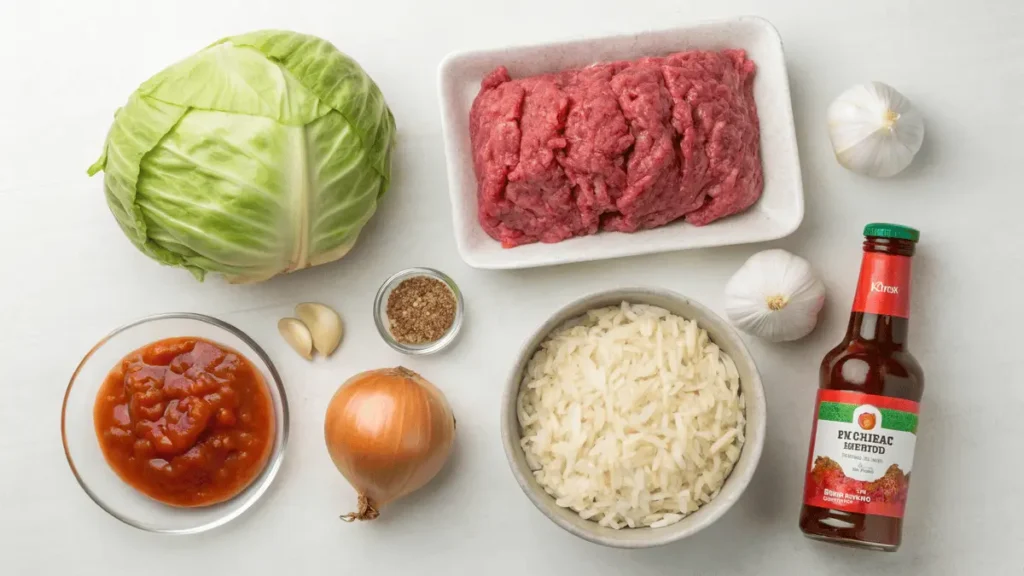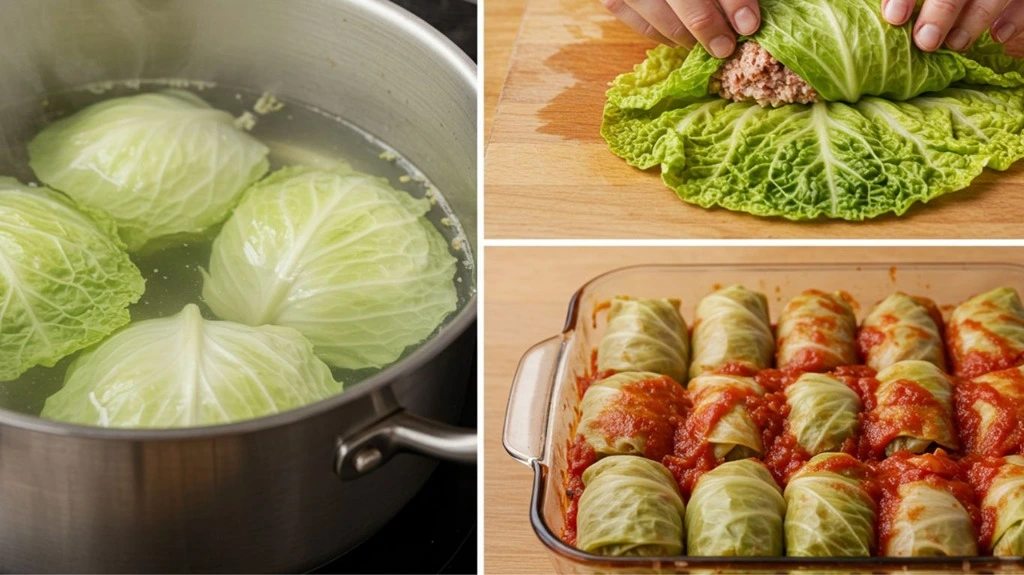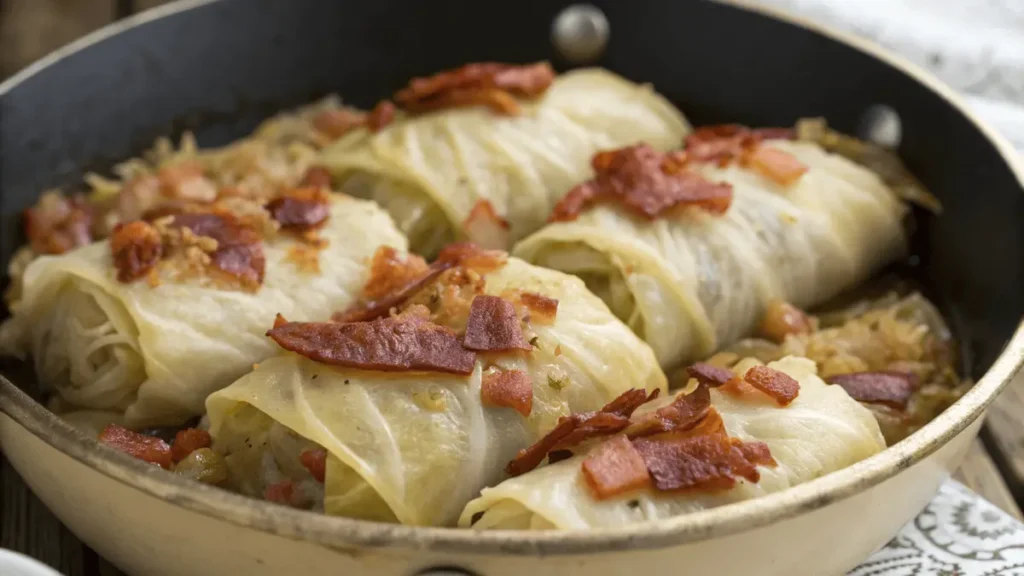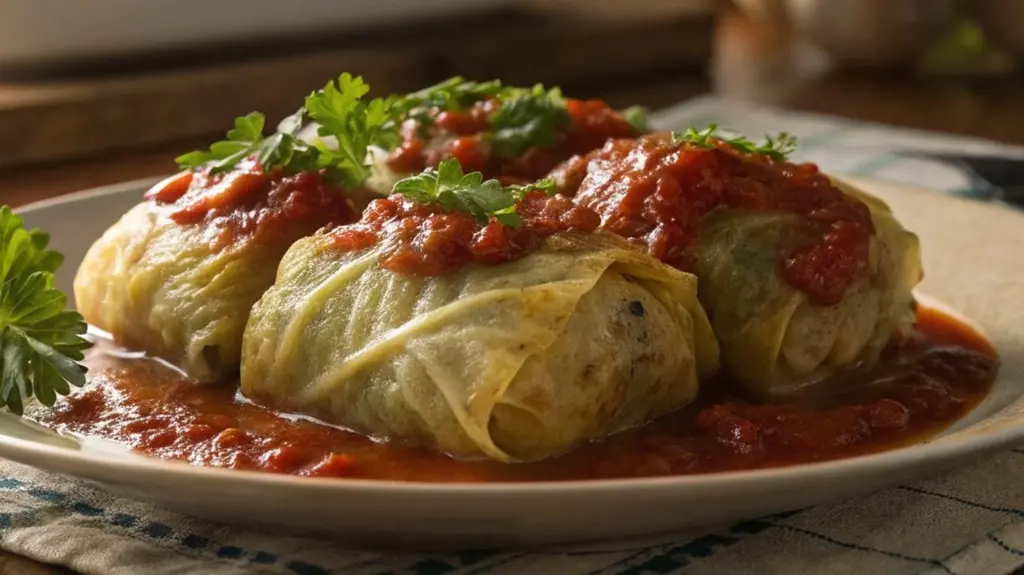Nothing says comfort food quite like a big plate of German cabbage rolls! In this article, we’ll take a cozy journey through the history, flavors, and secrets behind making this beloved old-fashioned dish. From prepping tender cabbage leaves to crafting juicy, savory fillings, you’ll learn it all. We’ll also chat about serving ideas, tasty variations, and answer common FAQs. Ready to roll? Let’s dive in!
Table of Contents
Introduction to German Cabbage Rolls
What Are German Cabbage Rolls?
German cabbage rolls, or Krautwickel as the locals fondly call them, are a hearty dish made by stuffing tender cabbage leaves with a savory mix of ground meat, rice, and spices. Once rolled up tightly, these little bundles are cooked slowly until bursting with flavor. The dish is usually bathed in a tomato-based sauce or sometimes a rich broth, creating an irresistible aroma that fills the entire house.
This authentic German food staple has been cherished for generations, offering a perfect balance of soft, flavorful cabbage and juicy meat fillings. Whether you’re a seasoned cook or a newbie in the kitchen, crafting homemade cabbage rolls is an experience that feels just as good as the first bite tastes!
A Brief History of Cabbage Rolls in German Cuisine
Believe it or not, stuffed cabbage dates back centuries, with roots tracing through Eastern Europe and Germany. German grandmothers, or Omas, often prepared these rolls during harvest time when cabbage heads were plump and ready.
Historically, the dish symbolized resourcefulness — using simple, affordable ingredients like ground beef and rice filling to create a hearty, satisfying meal. Over time, cabbage rolls became a must-have at family gatherings, holidays, and even everyday dinners. Today, german cabbage rolls continue to stand tall as a cherished piece of rustic, old-world German comfort food.
After all, there’s nothing quite like a plate of slow-cooked cabbage rolls to bring a taste of tradition right to your table!
Why You’ll Love This Old-Fashioned Recipe
Comfort Food at Its Best
When it comes to comfort food, nothing quite hits the spot like german cabbage rolls. They bring that homemade goodness you crave after a long day. Each bite feels like a cozy hug — savory, tender, and downright satisfying.
Unlike quick meals, these cabbage rolls slow-cook to perfection, letting flavors blend beautifully. Plus, the combination of seasoned meat, soft cabbage, and rich sauce creates a meal that’s hearty without feeling heavy. It’s no wonder families have passed down this recipe for generations!
Even better, german stuffed cabbage fits just about any occasion. Whether you’re hosting a big family dinner or simply want a little extra warmth at home, these rolls never disappoint. And honestly, who can say no to a plate of melt-in-your-mouth cabbage goodness?
Authentic German Flavors
One of the best parts about german cabbage rolls is their unmistakable flavor. With each roll, you get that old-world mix of simple spices, earthy cabbage, and juicy meat filling.
Traditionally, ingredients stay minimal — letting natural flavors shine through. A bit of onion, garlic, salt, pepper, and sometimes nutmeg is all you need. If you really want to boost things, a splash of tomato sauce or broth takes these rolls from great to unforgettable!
Whether you grew up with krautwickel or are discovering them for the first time, their timeless taste will have you hooked from the very first bite.
Ingredients Needed for Traditional German Cabbage Rolls
Essential Ingredients for Cabbage Rolls
To whip up classic german cabbage rolls, you don’t need anything fancy. In fact, you probably already have most of the ingredients sitting in your kitchen!

Here’s a basic list to get you started:
- 1 large head of cabbage (green or savoy cabbage works great)
- 1 lb ground beef (some use a beef-pork mix for richer flavor)
- 1 cup cooked rice
- 1 small onion, finely chopped
- 2 cloves garlic, minced
- 1 egg (for binding the filling)
- Salt and pepper to taste
- Tomato sauce or crushed tomatoes
- Beef broth or water for cooking
Optional, but delicious add-ins:
- A handful of chopped parsley
- A pinch of paprika or nutmeg
- A few slices of crispy bacon for topping
Using fresh ingredients really makes a difference here. After all, the beauty of homemade cabbage rolls lies in their simple, hearty foundation!
Choosing the Best Cabbage and Meat
When picking cabbage, go for heads that are firm but not too tight. You want the leaves to be easy to peel without tearing. Savoy cabbage is often a top choice because of its softer, flexible leaves.
As for the meat, ground beef is traditional, but mixing it with pork adds an extra layer of juiciness. Some even throw in a little ground veal if they’re feeling fancy! Either way, using good-quality meat ensures your german cabbage rolls turn out tender and flavorful.
Trust me, a few smart choices at the store now will make your kitchen smell like a German grandmother’s by dinnertime!
Step-by-Step: How to Make German Cabbage Rolls

Preparing the Cabbage Leaves
First things first, you gotta soften those cabbage leaves! Bring a big pot of salted water to a gentle boil. Then, carefully peel off the outer layers of a large head of cabbage. If the leaves are stubborn, no worries — just cut around the core a little to loosen them up.
Drop a few leaves at a time into the boiling water for about two to three minutes. You’ll notice they soften up and become pliable — that’s your cue! Quickly remove them and dunk them into ice water to stop the cooking. Pat them dry and set them aside. Now you’re ready for some serious rolling action!
If you’re short on time, another option is to freeze the whole cabbage overnight. As it thaws, the leaves will naturally soften. Easy peasy!
Crafting the Meat Filling
While the cabbage cools, it’s time to whip up that delicious filling. In a large bowl, mix together:
- 1 lb of ground beef (or a beef-pork combo if you’re feeling fancy),
- 1 cup cooked rice,
- 1 small chopped onion,
- 2 cloves minced garlic,
- 1 egg,
- a pinch of salt and pepper.
Want a little extra kick? Toss in a sprinkle of paprika or nutmeg. Stir everything together until it’s just combined — but don’t overmix, or your filling could get tough.
Rolling and Cooking the Cabbage Rolls
Place a cabbage leaf flat on a clean surface. Scoop about two tablespoons of filling onto the center. Fold the sides in like a burrito and roll it up tightly. Boom — you’ve got yourself a cabbage roll!
Arrange the rolls seam-side down in a deep baking dish or Dutch oven. Pour a hearty amount of tomato sauce or crushed tomatoes over the top, enough to cover them well. You can also add a splash of beef broth for extra richness.
Cover tightly with foil or a lid. Bake at 350°F for about 1.5 to 2 hours, until everything is bubbling and your german cabbage rolls are tender and irresistible.
If you love easier twists on classics, don’t miss this recipe for Skillet Cabbage Rolls — it’s a simpler, one-pan version that’s just as comforting!
Pro Tips for Perfect Old-Fashioned German Cabbage Rolls
How to Prevent Cabbage Rolls from Falling Apart
Nobody wants their gorgeous german cabbage rolls unraveling halfway through dinner! To keep them tight and pretty:
- Don’t overstuff the cabbage leaves — a little goes a long way.
- Always tuck in the sides firmly before rolling.
- Arrange them snugly in the pan so they stay cozy and supported while cooking.
Also, using soft, flexible cabbage (like savoy) makes rolling so much easier. If your leaves rip, just overlap two smaller pieces and roll them up like normal. No one will even know!

Flavor Enhancements: Sauerkraut, Bacon, and Tomato Sauces
While the basic recipe is mouthwatering on its own, there’s always room for extra magic! Many traditional recipes call for layering a bit of sauerkraut between the rolls for a punch of tangy flavor.
Adding a few slices of crispy bacon on top before baking is another old-school trick that takes your stuffed cabbage to the next level. And don’t forget about the sauce — whether you go with classic tomato, rich beef broth, or a creamy paprika blend, a great sauce is what really seals the deal.
For more hearty comfort foods like this, check out other tasty options on our site — you might just find a new family favorite!
Variations of German Cabbage Rolls
Classic Beef Version vs Pork Mixture
When you think of german cabbage rolls, you probably picture a classic beef and rice filling tucked into tender cabbage leaves. It’s simple, hearty, and oh-so-satisfying. However, there’s more than one way to roll — literally!
A popular twist on the classic is mixing ground beef with ground pork. Pork adds a rich, juicy flavor that gives the filling extra tenderness. Some even add a bit of ground veal for a real old-school treat!
Feeling adventurous? A handful of sautéed mushrooms in the filling can bring a deep, earthy flavor without changing the heart of the dish.
Whether you stick with beef or mix it up, each bite of german cabbage rolls tells a story of comfort and tradition.
Vegetarian and Modern Twists
Guess what? You don’t need meat to enjoy amazing cabbage rolls. Many home cooks today are giving this old favorite a fresh makeover.
For a vegetarian spin, try filling your cabbage leaves with a mix of cooked lentils, brown rice, diced carrots, and savory spices. Add a little feta or goat cheese if you like a creamy kick. Yum!
Or, go modern with quinoa, black beans, and spicy tomato sauce for a fusion that’s healthy but still cozy. No matter which way you roll, the spirit of authentic german food shines through — even with a twist.
Serving Suggestions for Cabbage Rolls
Traditional Side Dishes to Serve With
Now that your german cabbage rolls are ready, let’s talk about what to serve alongside them. Trust me, picking the right sides makes the meal even better!
Mashed potatoes are a classic choice. Their buttery richness pairs perfectly with the tangy tomato sauce. Another favorite? Buttered noodles or spaetzle — those little German dumplings that soak up all that tasty sauce.
Don’t forget a simple green salad or steamed veggies to add some fresh crunch. Sauerkraut is also a must for true German flair, giving a lovely sharp contrast to the rolls’ hearty filling.
Sauce Ideas to Complement the Rolls
Although traditional cabbage rolls are cooked in a tomato-based sauce, you can mix things up easily!
Try a creamy mushroom sauce for a rich, earthy flavor. Or simmer your rolls in beef broth with onions for a deeper, savory kick. Want something tangier? A zesty paprika sauce brings a bold, smoky note that’s absolutely divine.
No matter what, your stuffed cabbage deserves a sauce that makes every bite unforgettable!
Storing and Reheating German Cabbage Rolls
Best Storage Practices for Freshness
Made too many german cabbage rolls? Lucky you! Storing them the right way means you’ll have an easy, comforting meal ready anytime.
First, let the rolls cool completely. Then, place them in an airtight container, layering them carefully with a bit of sauce between each layer. This helps keep them moist. Stored in the fridge, they’ll stay fresh for up to four days.
If you want to freeze them, no problem! Wrap each cabbage roll individually in plastic wrap, then pop them into a freezer bag or airtight container. They’ll keep well for about two to three months. Just be sure to thaw them in the fridge overnight before reheating.
Reheating Without Drying Them Out
To reheat german cabbage rolls, slow and gentle is the name of the game.
Warm them in a covered dish at 325°F for about 20 to 30 minutes, adding a little extra sauce or broth to keep them juicy. If you’re in a hurry, you can microwave them too, but cover them with a damp paper towel so they don’t dry out. Either way, they’ll taste just as amazing as the first time!
FAQs About German Cabbage Rolls
Q: Which country has the best cabbage rolls?
That’s a tough one because so many countries have their own amazing version of cabbage rolls! Germany, Poland, Ukraine, and Romania are all famous for their unique takes.
If you love hearty, rich flavors, many folks say German cabbage rolls (Krautwickel) are the best — especially because they balance savory beef, tender cabbage, and rich tomato sauce beautifully. Of course, it really comes down to personal taste and family tradition!
Q: What is a German cabbage dish called?
In Germany, cabbage rolls are lovingly called Krautwickel or sometimes Kohlrouladen.
These names simply mean “cabbage wraps” or “cabbage rolls.” You’ll often find german cabbage rolls stuffed with a flavorful mix of ground beef, pork, rice, and spices, all simmered in a cozy tomato or broth-based sauce.
Other classic German cabbage dishes include Rotkohl (sweet and sour red cabbage) and Sauerkraut, a fermented cabbage side loved all over the world!
Q: What is the difference between halupki and golumpki?
Honestly, not much!
Both halupki and golumpki are Eastern European versions of stuffed cabbage rolls, especially popular among Polish and Slovak communities.
Golumpki (also spelled golabki) is the Polish name for cabbage rolls filled with meat and rice.
Halupki is the Slovak name for basically the same thing.
Some differences pop up depending on family traditions — for example, slight changes in seasonings, sauce styles, or the kind of meat used — but overall, they’re delicious cousins of german cabbage rolls.
Q: How to make lazy man’s cabbage rolls?
Lazy man’s cabbage rolls are a fun and easy twist when you don’t feel like rolling each leaf!
Here’s how:
– Chop the cabbage into bite-sized pieces.
– Brown your ground beef (or pork) with onions and garlic.
– Mix the meat with cooked rice, seasoning, and cabbage chunks.
– Layer everything in a baking dish, pour tomato sauce or broth over it, and bake until bubbly and tender.
The flavor is all there — but without the extra rolling work! It’s a great way to enjoy the cozy comfort of stuffed cabbage with half the effort.
Final Thoughts: Bringing Tradition to Your Table
The Joy of Homemade German Cabbage Rolls
There’s just something special about making german cabbage rolls from scratch. It’s more than just a meal — it’s an experience. From softening those cabbage leaves to rolling up each bundle with care, every step brings a little piece of tradition into your kitchen.
Not to mention, the smell that fills the house while they bake is pure magic! It’s the kind of comfort that warms you from the inside out, no matter the season.
So whether you’re whipping up a batch for Sunday dinner or sharing a taste of home with friends, these authentic german food classics are sure to leave smiles all around the table.
Keeping Family Traditions Alive
By making old-fashioned dishes like german cabbage rolls, you’re not just cooking — you’re keeping beautiful traditions alive.
Each roll carries a bit of history, a sprinkle of love, and a whole lot of flavor. And honestly, once you taste that first bite, you’ll wonder why you didn’t start making them sooner!
Ready to roll? Trust us — your future self will thank you.
For more details about this recipe, check out Cabbage roll.

